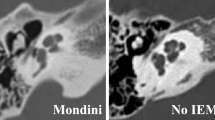Abstract
Brainstem auditory evoked responses (BAER) were studied in 20 children with clinically diagnosed and CT-confirmed congenital hydrocephalus before and after shunt surgery. Ninety-five percent of the children showed abnormal responses preoperatively. Prolonged wave V latency was the most common abnormality, followed by increased interwave latencies. Total absence of evoked responses was more common in children with communicating hydrocephalus. Following shunt surgery 50% of cases returned to normal and 20% showed a significant improvement. Abnormalities persisted in 10% of cases. BAER abnormalities referrable to caudal brainstem dysfunction recovered first, following CSF diversion. Study of BAER is useful for identifying physiological brainstem abnormalities in hydrocephalic children and promises to be a sensitive non-invasive diagnostic tool for the detection of “non-infective complications” of shunt surgery, if performed serially during follow up.
Similar content being viewed by others
References
Benna P, Gilli M, Fenero P, Bergamasco B (1982) Brainstem auditory evoked potentials in supratentorial tumours. Electroencephalogr Clin Neurophysiol 54:8–9
Gilbert LN, Jones KL, Rorke LB, Chernoff GF, James HE (1986) Central nervous system anomalies associated with meningomyelocele, hydrocephalus and the pathogenesis of posterior neutral tube closure defects. Neurosurgery 18:559–563
Grossman RG, Turner JW, Miller JD, Rowan JO (1973) The relationship between cortical electrical activity, cerebral perfusion pressure and cerebral blood flow during increased intracranial pressure. Stroke 4:346
Grossman RG, Turner JW, Miller JD, Rowan JO (1975) The relationship between cortical electrical activity cerebral perfusion pressure and cerebral blood flow during increased intracranial pressure. In: Langfitt TW, McHenry LC Jr, Reivich M (ed) Cerebral circulation and metabolism. Springer, New York Berlin Heidelberg, pp 232–234
Jewett DL, Ramano MN, Willisters JS (1970) Human auditory evoked potentials. Possible brainstem components detected on the scalp. Science 167:1517–1518
Kraus N, Ozdamer O, Heydemann PT, Stein L, Reed NL (1984) Auditory brainstem responses in hydrocephalic patients. Electroencephalogr Clin Neurophysiol 59:310–317
McPherson D, Blanks BA, Foltz E (1984) Intracranial pressure effects on auditory evoked responses in the rabbit. Preliminary report. Neurosurgery 14:161–166
Nagao S, Roccaforte P, Moody R (1979) Acute intracranial hypertension and auditory brainstem responses. 1. J Neurosurg 51:669–676
Nagao S, Roccaforte P, Moody R (1979) Acute intracranial hypertension and auditory brainstem responses. 2. J Neurosurg 51:846–851
Sabattini L (1982) Evaluation and measurement of normal ventricular and subarachnoid spaces by CT. Neuroradiology 23:1–5
Suttan LN, Byung-Kyncho, Jaggi J, Joseph PM, Bruse DA (1986) Effects of hydrocephalus and increased intracranial pressure on auditory and somatosensory evoked responses. Neurosurgery 18:756–761
Author information
Authors and Affiliations
Rights and permissions
About this article
Cite this article
Venkataramana, N.K., Satishchandra, P., Hegde, A.S. et al. Evaluation of brainstem auditory evoked responses in congenital hydrocephalus. Child's Nerv Syst 4, 334–338 (1988). https://doi.org/10.1007/BF00270606
Received:
Issue Date:
DOI: https://doi.org/10.1007/BF00270606




